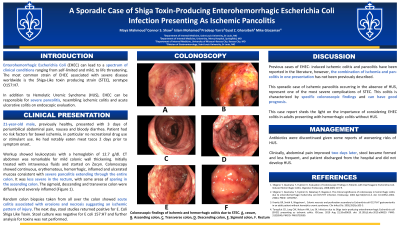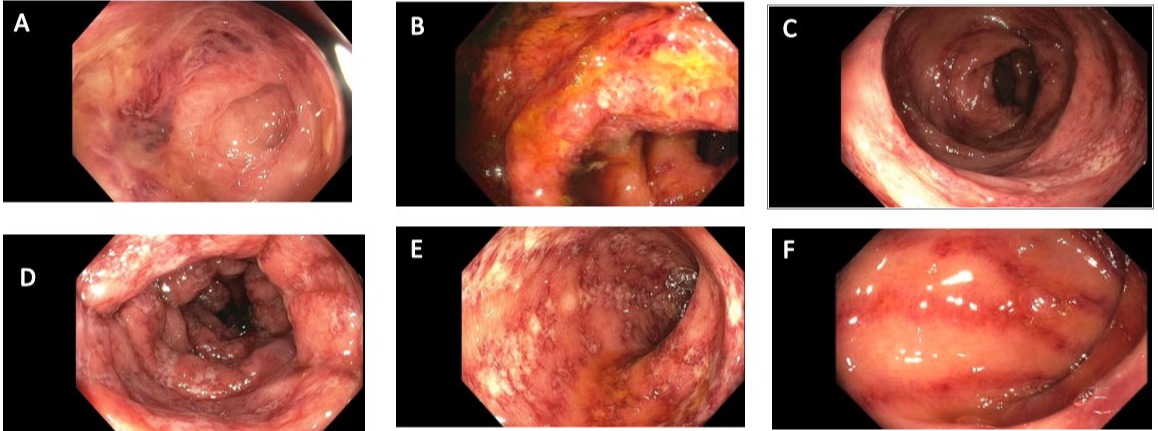Monday Poster Session
Category: Colon
P1678 - A Sporadic Case of Shiga Toxin-Producing Enterohemorrhagic Escherichia coli Infection Presenting as Ischemic Pancolitis
Monday, October 23, 2023
10:30 AM - 4:15 PM PT
Location: Exhibit Hall

Has Audio

Maya Mahmoud, MD
Saint Louis University
St. Louis, MO
Presenting Author(s)
Maya Mahmoud, MD1, Connor S. Shaw, DO2, Islam Mohamed, MD3, Pradeep Yarra, MD1, Eyad Z. Gharaibeh, MD1, Mike Giacaman, MD1
1Saint Louis University, St. Louis, MO; 2Mercy Hospital Saint Louis, St. Louis, MO; 3University of Missouri-Kansas City, Kansas City, MO
Introduction: Enterohemorrhagic Escherichia Coli (EHEC) can lead to a spectrum of clinical conditions ranging from self-limited and mild, to life threatening. The most common strain of EHEC associated with severe disease worldwide is the Shiga-Like toxin producing strain (STEC), serotype O157:H7. In addition to Hemolytic Uremic Syndrome (HUS), EHEC can be responsible for severe pancolitis, resembling ischemic colitis and acute ulcerative colitis on endoscopic evaluation.
Case Description/Methods: A 21-year-old male, previously healthy, presented with 3 days of periumbilical abdominal pain, nausea and bloody diarrhea. Patient had no risk factors for bowel ischemia, in particular no recreational drug use or stimulant use. He had notably eaten meat tacos 2 days prior to symptom onset. Workup showed leukocytosis with a hemoglobin of 12.7 g/dl. CT abdomen was remarkable for mild colonic wall thickening. Initially treated with intravenous fluids and started on Zocyn. Colonoscopy showed continuous, erythematous, hemorrhagic, inflamed and ulcerated mucosa consistent with severe pancolitis extending through the entire colon. It was less severe in the rectum, with some areas of sparing in the ascending colon. The sigmoid, descending and transverse colon were diffusely and severely inflamed (Figure 1). Random colon biopsies taken from all over the colon showed acute colitis associated with erosions and necrosis suggesting an ischemic pattern of injury. The next day, stool studies returned positive for E. Coli Shiga Like Toxin. Stool culture was negative for E coli 157:H7 and further analysis for toxins was not performed. Antibiotics were discontinued given some reports of worsening risks of HUS. Clinically, abdominal pain improved two days later, stool became formed and less frequent, and patient did not develop HUS.
Discussion: Previous cases of EHEC- induced ischemic colitis and pancolitis have been reported in the literature, however, the combination of ischemia and pan-colitis in one presentation has not been previously described. This sporadic case of ischemic pancolitis occurring in the absence of HUS, represent one of the most severe complications of STEC. This colitis is characterized by specific colonoscopic findings and can have good prognosis. This case report sheds the light on the importance of considering EHEC colitis in adults presenting with hemorrhagic colitis without HUS.

Disclosures:
Maya Mahmoud, MD1, Connor S. Shaw, DO2, Islam Mohamed, MD3, Pradeep Yarra, MD1, Eyad Z. Gharaibeh, MD1, Mike Giacaman, MD1. P1678 - A Sporadic Case of Shiga Toxin-Producing Enterohemorrhagic Escherichia coli Infection Presenting as Ischemic Pancolitis, ACG 2023 Annual Scientific Meeting Abstracts. Vancouver, BC, Canada: American College of Gastroenterology.
1Saint Louis University, St. Louis, MO; 2Mercy Hospital Saint Louis, St. Louis, MO; 3University of Missouri-Kansas City, Kansas City, MO
Introduction: Enterohemorrhagic Escherichia Coli (EHEC) can lead to a spectrum of clinical conditions ranging from self-limited and mild, to life threatening. The most common strain of EHEC associated with severe disease worldwide is the Shiga-Like toxin producing strain (STEC), serotype O157:H7. In addition to Hemolytic Uremic Syndrome (HUS), EHEC can be responsible for severe pancolitis, resembling ischemic colitis and acute ulcerative colitis on endoscopic evaluation.
Case Description/Methods: A 21-year-old male, previously healthy, presented with 3 days of periumbilical abdominal pain, nausea and bloody diarrhea. Patient had no risk factors for bowel ischemia, in particular no recreational drug use or stimulant use. He had notably eaten meat tacos 2 days prior to symptom onset. Workup showed leukocytosis with a hemoglobin of 12.7 g/dl. CT abdomen was remarkable for mild colonic wall thickening. Initially treated with intravenous fluids and started on Zocyn. Colonoscopy showed continuous, erythematous, hemorrhagic, inflamed and ulcerated mucosa consistent with severe pancolitis extending through the entire colon. It was less severe in the rectum, with some areas of sparing in the ascending colon. The sigmoid, descending and transverse colon were diffusely and severely inflamed (Figure 1). Random colon biopsies taken from all over the colon showed acute colitis associated with erosions and necrosis suggesting an ischemic pattern of injury. The next day, stool studies returned positive for E. Coli Shiga Like Toxin. Stool culture was negative for E coli 157:H7 and further analysis for toxins was not performed. Antibiotics were discontinued given some reports of worsening risks of HUS. Clinically, abdominal pain improved two days later, stool became formed and less frequent, and patient did not develop HUS.
Discussion: Previous cases of EHEC- induced ischemic colitis and pancolitis have been reported in the literature, however, the combination of ischemia and pan-colitis in one presentation has not been previously described. This sporadic case of ischemic pancolitis occurring in the absence of HUS, represent one of the most severe complications of STEC. This colitis is characterized by specific colonoscopic findings and can have good prognosis. This case report sheds the light on the importance of considering EHEC colitis in adults presenting with hemorrhagic colitis without HUS.

Figure: Figure 1. Colonoscopic findings of ischemic and hemorrhagic colitis due to STEC. A. cecum, B. Ascending colon, C. Transverse colon, D. Descending colon, E. Sigmoid colon, F. Rectum
Disclosures:
Maya Mahmoud indicated no relevant financial relationships.
Connor Shaw indicated no relevant financial relationships.
Islam Mohamed indicated no relevant financial relationships.
Pradeep Yarra indicated no relevant financial relationships.
Eyad Gharaibeh indicated no relevant financial relationships.
Mike Giacaman indicated no relevant financial relationships.
Maya Mahmoud, MD1, Connor S. Shaw, DO2, Islam Mohamed, MD3, Pradeep Yarra, MD1, Eyad Z. Gharaibeh, MD1, Mike Giacaman, MD1. P1678 - A Sporadic Case of Shiga Toxin-Producing Enterohemorrhagic Escherichia coli Infection Presenting as Ischemic Pancolitis, ACG 2023 Annual Scientific Meeting Abstracts. Vancouver, BC, Canada: American College of Gastroenterology.
